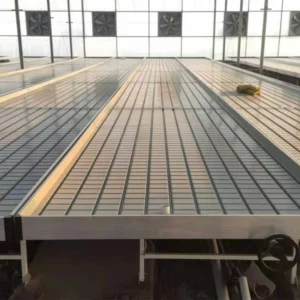Ebb and flow tables, also known as flood tables, are used in hydroponic and aquaponic systems to flood plant roots with nutrient-rich water and then drain it away. These tables require structural reinforcements to support the weight of the growing media, plants, and water, as well as to withstand the repetitive flooding and draining cycles.
Here are some structural reinforcements commonly used for ebb and flow tables:
- Sturdy Frame: The ebb and flow table should be supported by a sturdy frame constructed from durable materials such as metal or reinforced plastic. The frame provides structural support and stability to the table, preventing sagging or bowing under the weight of the growing media and water.
- Cross Bracing: Install cross bracing between the legs or support posts of the table to enhance structural integrity and prevent lateral movement or swaying. Cross bracing helps distribute weight evenly across the frame and reduces the risk of buckling or collapsing under load.
- Solid Bottom: Ensure that the bottom of the ebb and flow table is solid and rigid to support the weight of the growing media and water without flexing or bending. Use heavy-duty materials such as plywood, fiberglass, or reinforced plastic for the table bottom to provide adequate support and prevent warping or distortion over time.
- Reinforced Corners: Reinforce the corners of the ebb and flow table with additional bracing or corner supports to prevent stress concentrations and improve structural strength. Reinforced corners help distribute weight evenly and minimize the risk of corner failure or collapse.
- Leveling Feet: Install adjustable leveling feet or pads on the bottom of the ebb and flow table to ensure stability and provide a level surface for the table. Leveling feet allow for easy adjustment to compensate for uneven floors or surfaces, China Ebb And Flow Table supplier ensuring proper drainage and preventing water pooling.
- Waterproofing: Apply a waterproof sealant or liner to the interior surfaces of the ebb and flow table to prevent water leakage and damage to the structure. Waterproofing materials such as pond liner, rubber membrane, or epoxy coating create a watertight barrier that protects the table from moisture infiltration and extends its lifespan.
- Overflow Drainage: Incorporate overflow drainage channels or ports into the design of the ebb and flow table to prevent water from overflowing and causing flooding or structural damage. Overflow drains should be strategically positioned to divert excess water away from the table and ensure proper drainage during flooding cycles.
- Regular Inspection and Maintenance: Conduct regular inspections of the ebb and flow table to check for signs of wear, damage, or structural weakness. Replace worn or damaged components, tighten loose fasteners, and reinforce weak areas as needed to maintain structural integrity and prevent failures.
By implementing these structural reinforcements and maintenance practices, ebb and flow tables can support the weight of plants and water effectively, withstand the rigors of hydroponic and aquaponic growing systems, and provide a stable and durable platform for plant cultivation.

What structural reinforcements are needed to support a Ebb And Flow Table?
